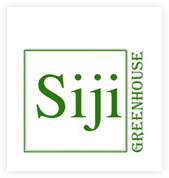These days, there are few public indoor spaces that do not have at least a few indoor plants displayed. Sometimes obvious care and attention have been given to their selection and presentation sometimes not, but the fact remains that some effort and expense has been made.

What are the Benefits of
Indoor Plants?
Why should one consider the inclusion of indoor plants in any scheme? The reason that immediately springs to mind is for their aesthetic value, but there are more subtle benefits which may often be overlooked. Some of these are looked at below.
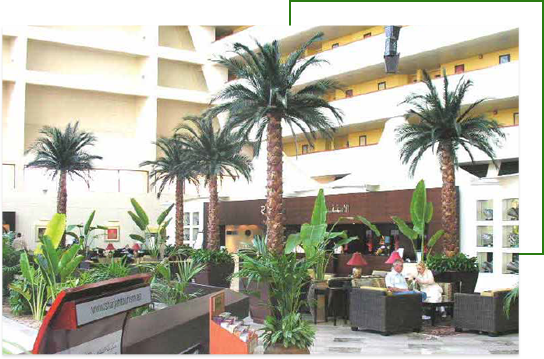
Space Enhancement
The visual and aesthetic contribution of indoor plants to public spaces is perhaps the most obvious, yet it is actually quite difficult to quantify the benefits in a tangible way. One method has been tried in a postgraduate study, which got people to pick one of two options covering a range of potential reactions to areas that contained or did not contain indoor plants. The options were very simple and directly opposing, (e.g. quiet/noisy; welcoming / unwelcoming etc.), and the results assessed to give an indication of the subjects subliminal reaction.
The reactions were quite revealing. The inclusion of plants consistently out-scored those when plants were excluded, whereby areas with indoor plants were perceived to be:
- More welcoming
- More relaxing
- More cheerful
- More ornate
- More interesting
- Quieter
This was only one study, there is much more evidence however that indoor plants are perceived as an integral and important element of indoor spaces. Again it is somewhat subjective, but strong support is given by the preponderance of new public buildings devoting more time, thought, energy and expense on the indoor plant displays. Rest assured that as many of these buildings are commercial enterprises they would not be so keen to pay such careful attention to the indoor landscape if they felt that there was no economic benefit to be gained. As stated, there is little quantifiable evidence to support the idea of the indoor landscape providing economic benefits, but some educated guesses can be made to explain how it might play a role.
Referring to the above list, the public would feel more welcome, more relaxed, less stressed and happier in an environment with indoor landscaping. As such when given the choice, they are more likely to select the more comfortable and welcoming environment.
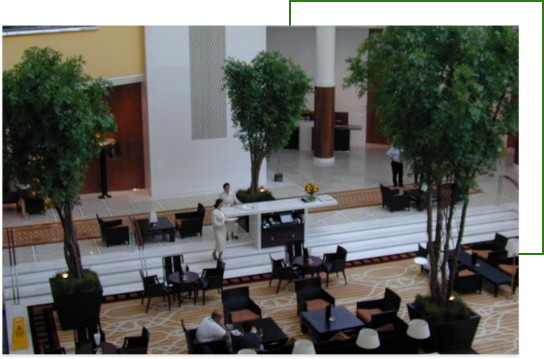
In the case of a hotel, people expect to be able to relax and enjoy a hassle-free stay in a luxurious setting. The inclusion of high-quality plants, well and tastefully displayed, adds to the feeling of luxury, comfort, and wellbeing, the knock-on effect of which will be to enrich the overall experience. This, in turn, reflects favourably on repeat booking potential and recommendation to others.
Where a choice of venue is not an option, but space can still be considered “Public” there are still benefits to be gained aside from the obvious aesthetic contribution.
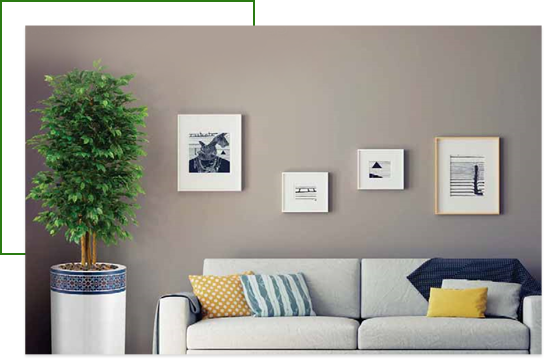
In the case of a commercial office setting, the better more relaxed environment created by the inclusion of indoor plants is thought to increase individual productivity. In addition to this direct benefit, is the benefit of the luxurious appearance of the office setting and welcoming feeling generated and enjoyed by visitors, projecting an image of success, attention to detail and thoughtfulness.
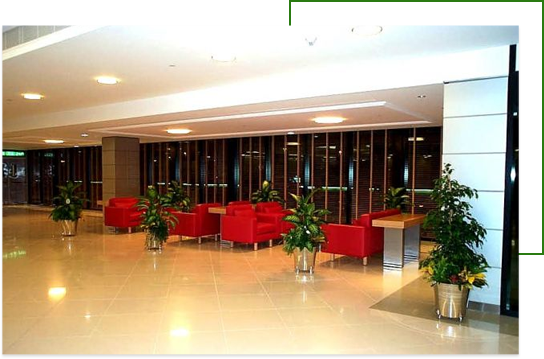
In the case of airports, the same arguments hold true. Although travelers themselves may have a limited choice in their selection of airport, their experience can be enriched and friends and relatives collecting or dropping them off may be influenced to stay and take advantage of the airport’s additional facilities. Additionally, airports are the first experience travelers are exposed to when arriving at a new destination and providing a favourable setting will undoubtedly contribute to their positive first impressions.
Environmental factors
Indoor plants contribute in a number of ways to improving the indoor environment. Live plants in particular due to the physiology relating to their growth processes. (Artificial plants or preserved plants can also provide some benefits such as reducing background noise, hiding ugly features, highlighting/enhancing key features or areas and to delineate areas or assist with zoning and breaking up large open spaces, but live plants can provide these and much more).
Air quality
The indoor environment can vary hugely depending on the building’s purpose and design. In the United Arab Emirates, many public buildings have a large preponderance of glass which lets in a lot of light (and heat). This is combated by the ubiquitous use of air conditioning. Air conditioning in turn adversely affects the air quality, making it drier.
Crowded indoor public spaces can also suffer from elevated carbon dioxide levels created through human biological processes namely breathing, and to a lesser extent from the by-products of electrical equipment.
In buildings that are too dry and have high carbon dioxide levels, people often tend to feel a little lethargic. (With regard to humidity, 40% – 60% RH is the optimal value for human comfort).
Plants whilst actively photosynthesizing, extract carbon dioxide from the air and produce oxygen as a natural by-product of growth. They also release water vapour naturally through pores called stomata in their leaves during transpiration. Both these factors can contribute to improving the indoor environment.
An associated benefit to plant transpiration is the evaporative cooling effect that occurs during the process. Heat is transferred to the evaporating vapour at the leaf surface and removed from the surrounding air.
Plants are also associated with reducing dust in interiors. It has been suggested that dust particles are attracted to and stick to plant leaf surfaces.
Noise
Interior spaces with a preponderance of hard reflective surfaces can benefit from the introduction of plants, which can help to reduce background noise.
Hiding unattractive building elements
Indoor plant displays can be used to combine aesthetic qualities whilst serving a useful purpose. Most interior spaces, no matter how well designed have areas that are visually unattractive, such as baggage storage areas in hotels/airports, service entrances, etc. these can be screened or softened with carefully positioned plant arrangements.
Delineating space
In the case of a shopping mall, this would bring the public into close proximity of the outlets within the landscaped mall which would undoubtedly benefit the outlets. The mall owners, in turn, would benefit from being able to charge a premium for space within the mall. In a more relaxed atmosphere, the public are likely to spend more time at the mall and are therefore exposed to a potential spending spree in a better frame of mind than would otherwise be the case.
Psychological factors
In the workplace
It is now strongly supported by research and observation that high quality plants can play a significant part in reducing absenteeism from the workplace. The reasons are unclear, but it is likely that many of the factors are a subtle combination of the subliminal effects described above, namely, improved air quality, reduction of noise and the aesthetic quality of the displays themselves. All these factors contribute to a better sense of well being, reduced stress levels and open the way for a more relaxed workforce, better able to focus on the task at hand.
The fact that an employer has taken the time to consider their employees and has been willing to invest in their sense of comfort in the workplace may also play a factor by passing the message that “senior management does care”.
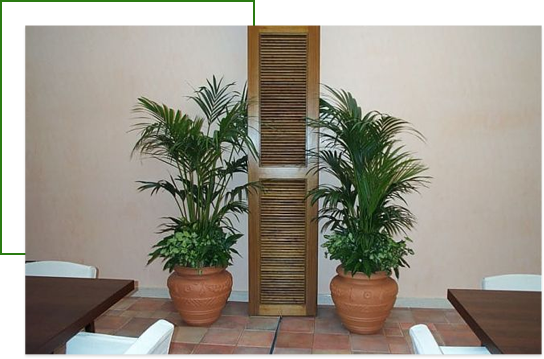
There is no evidence to support the idea that filling every available space with a plant is necessary to achieve the desired result. On the contrary strategic placement of high-quality plants is thought to be more beneficial. Areas to target include; in close proximity to workstations, and in areas where staff congregate to relax and take breaks. In fact, fewer can be better if attention is paid to the type of plant used and its position.
Guidance and identification
Plants can be useful in large spaces to help the functionality of the space providing attractive indoor “landmarks”. They can be used to break up spaces and provide subtle ways of indicating directional movement. They can also be used to mark specific areas, for example, information desks, bathrooms etc. Direction to such places which may be difficult to find in a large area could be made easier if someone giving direction can say “it’s behind the large tree in the red pot”.
